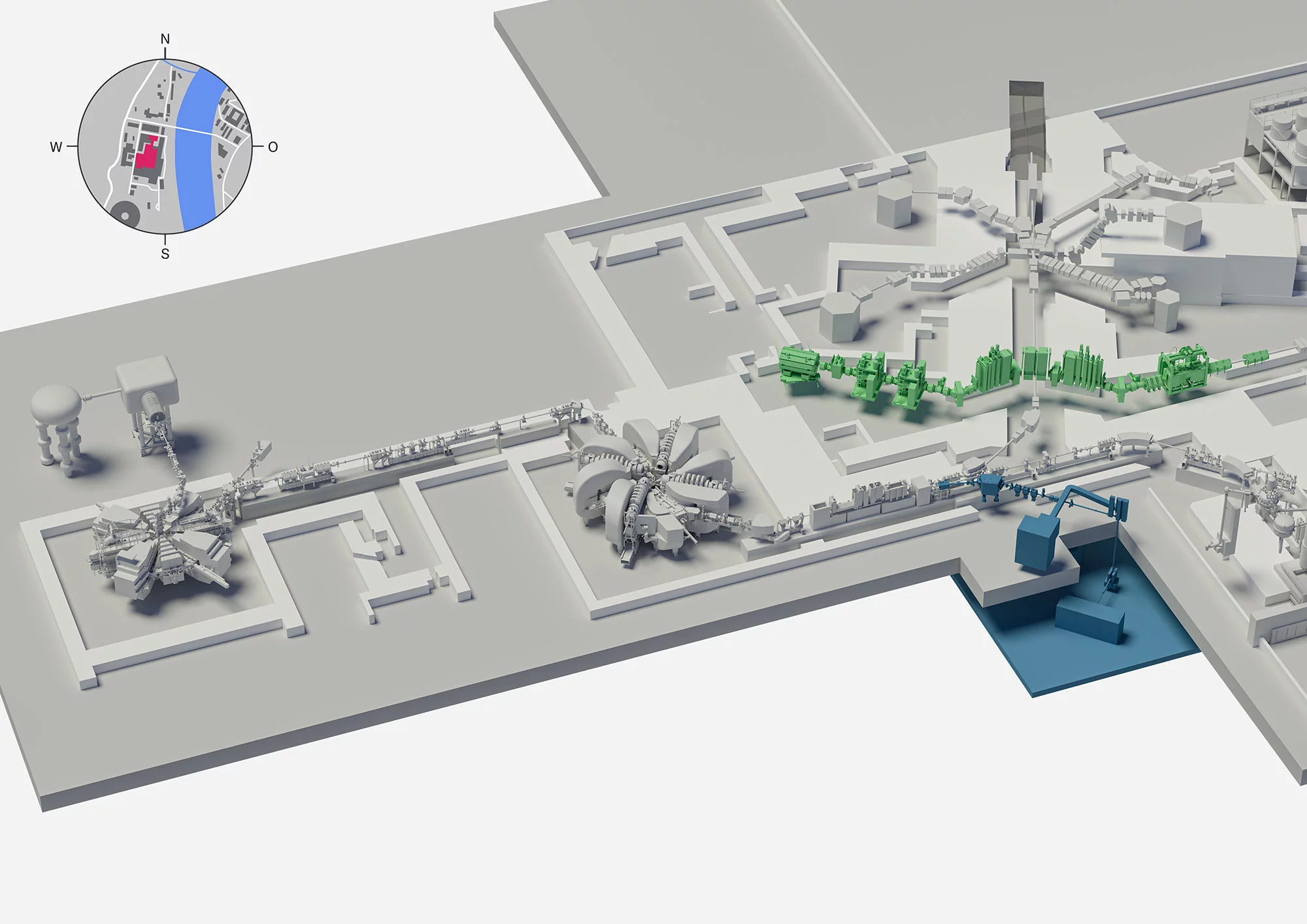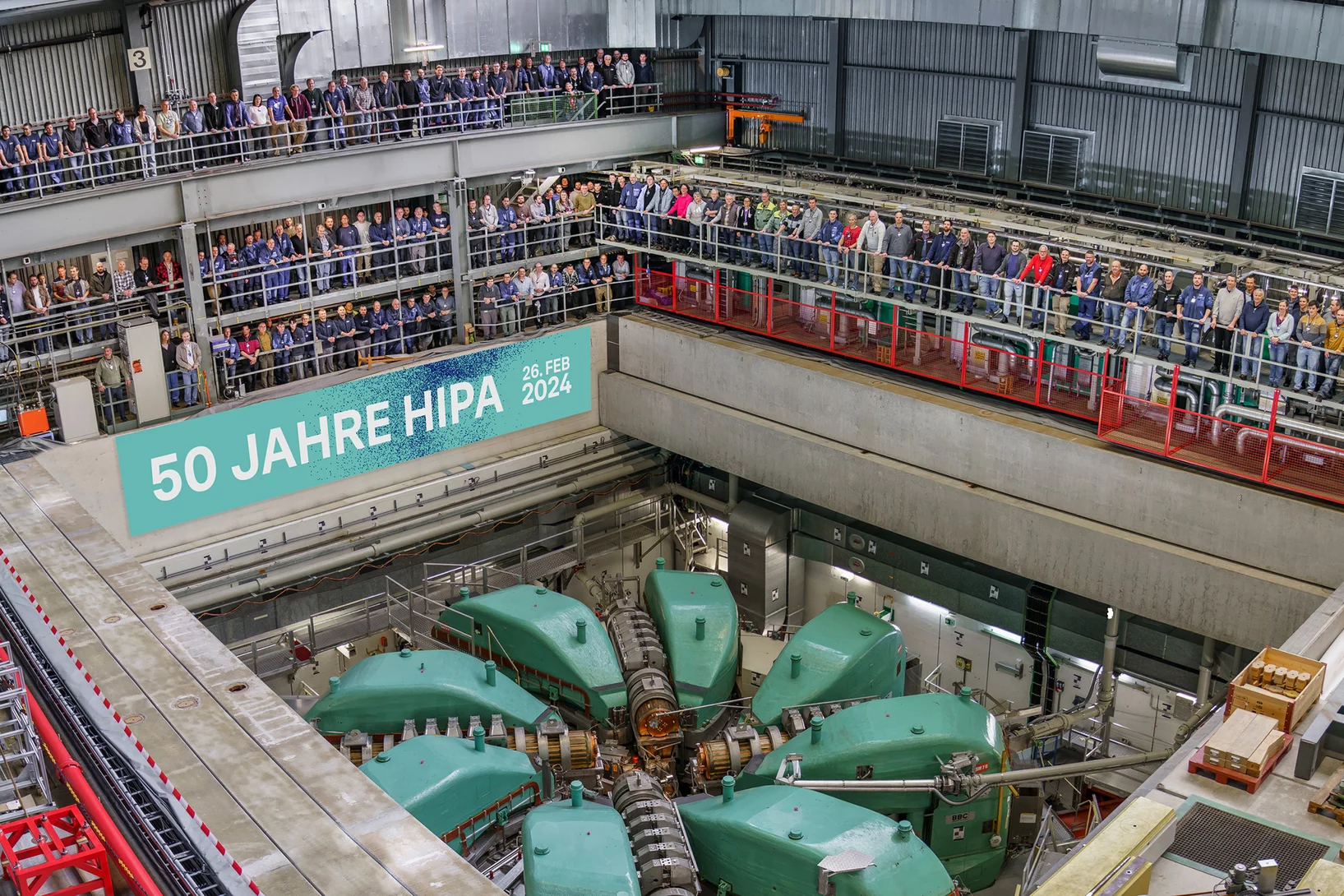The proton accelerator HIPA has been in operation since 1974. HIPA stands for High-Intensity Proton Accelerator. Thanks to constant maintenance and several expansions of the facility, the local beamlines and experiments have been the site of world-renowned, cutting-edge research for around five decades. To further invest in its strengths, a significant new upgrade is planned: IMPACT (Isotope and Muon Production with Advanced Cyclotron and Target Technologies). This consists of two parts: HIMB (High-Intensity Muon Beams) and TATTOOS (Targeted Alpha Tumour Therapy and Other Oncological Solutions).

(Graphic: Paul Scherrer Institute/Mahir Dzambegovic)
Several large particle accelerators for research are in operation at PSI. One particularly large facility is the one that accelerates protons: HIPA, the High-Intensity Proton Accelerator. HIPA went into operation in 1974 and thus can boast of being 14 years older than PSI itself, which was founded in 1988 as a merger of two predecessor institutes.
HIPA is PSI’s proton accelerator. HIPA stands for High-Intensity Proton Accelerator.
IMPACT is a planned upgrade to HIPA, which is pending for the research funding period starting in 2025. IMPACT stands for Isotope and Muon Production with Advanced Cyclotron and Target Technologies. IMPACT consists of two parts: HIMB and TATTOOS.
HIMB stands for High-Intensity Muon Beams. This part of IMPACT includes a renovation of the muon facility so that, in the future, up to ten billion muons per second can be used for research there.
TATTOOS stands for Targeted Alpha Tumor Therapy and Other Oncological Solutions. This second part of IMPACT includes a new isotope production facility where so-called radionuclides are to be produced for targeted cancer treatment and diagnostics.
From the start, HIPA was a world-famous system and often ahead of its time: It always delivered an impressive number of protons per second, which, through several innovations at the facility, now exceeds its original design target by more than a factor of 20. The accelerated protons and the secondary particles which they can produce are used at diverse experiment stations and serve many high-profile long-term experiments. The scientific possibilities surrounding HIPA are exploited by PSI researchers themselves as well as by external Swiss and international researchers from both academia and industry.
A comprehensive, strategic upgrade is now set to make HIPA even more attractive for cutting-edge science. IMPACT. This acronym stands for Isotope and Muon Production with Advanced Cyclotron and Target Technologies. PSI, the University of Zurich, and the University Hospital of Zurich are jointly involved in the upgrade project IMPACT. At PSI, IMPACT will enable significant improvements in two areas of the research facility.
HIMB: More muons for outstanding experiments
On the one hand, an area of the facility where muons are generated as secondary particles is being renovated and improved. This part of IMPACT is called HIMB, short for High-Intensity Muon Beams.
PSI already holds the world record for the number of muons that are produced per second for research purposes. With HIMB, this intensity is expected to increase again, by a factor of 100, to ten billion muons per second in the future. In addition, a new laboratory is planned at the University of Zurich, where infrastructure for HIMB’s new experimental setups is to be established.
At PSI muons are used, on the one hand, for the investigation of materials. This concerns fundamental properties of matter. On the other hand, muons are also used in questions of particle physics, for example to pursue previously unsolved mysteries of the universe. Both areas require the enormous amounts of muons that can only be produced at PSI.
TATTOOS: Radionuclides for targeted tumour therapy
The second part of IMPACT is called TATTOOS: Targeted Alpha Tumour Therapy and Other Oncological Solutions. With TATTOOS, PSI wants to significantly expand its current production of radionuclides. Radionuclides are medicinal substances that can be used to treat cancer. At PSI, the Center for Radiopharmaceutical Sciences specialises in research on these active agents.
A new facility is being built as part of TATTOOS where high-energy HIPA protons will be fired at specific materials – so-called targets – to produce a variety of useful radionuclides. The researchers would like to use these radionuclides to develop drugs that perform a dual function in the fight against tumours: They should first mark the tumours for precise diagnosis, and in a second step they should target and destroy the tumour cells specifically on site. To bring these new drugs into clinical use, PSI is working on TATTOOS with the University of Zurich and the University Hospital of Zurich.
Far-reaching plans
With the decision of the Swiss Parliament at the end of 2024 to finance the ERI Dispatch on the promotion of education, research and innovation in the years 2025 to 2028, the project entered the implementation phase at the beginning of 2025. HIMB is to be realised by 2028, TATOOS by 2030.
News
IMPACT: Upgrade at PSI research facility approved
Financing for renovations to PSI’s proton accelerator facility has been approved by the Swiss Parliament.
IMPACT for Swiss society
World leader in muons and in production of medical radionuclides: The far-reaching significance of the planned upgrade.
Protons and other particles: The HIPA facility turns 50
Since 1974 HIPA has been accelerating protons for research.



